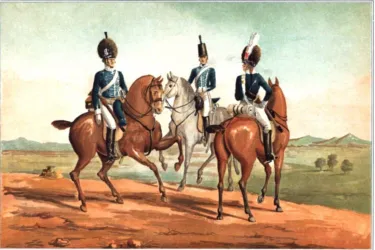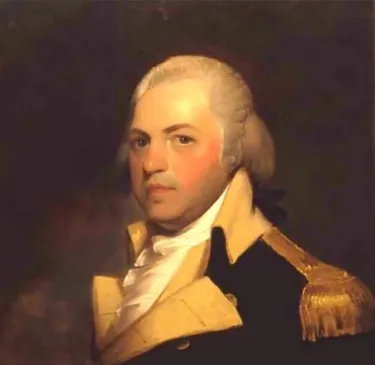By the 18th century, cavalry represented one of the three basic troop types of any European army, along with the infantry and artillery. Mounted troops came in a myriad of different types depending on the role that they played on the battlefield. Light cavalry, such as hussars, rode small quick horses and carried light weapons ideal for scouting and skirmishing. Heavy cavalry, including cuirassiers and lancers, on the other hand, were often armored and were mounted on strong powerful horses which they used to smash and break enemy formations in close combat. The nature of the terrain and the tactical realities of the American Revolution reduced the use of cavalry, forcing battlefield commanders to adapt their tactics from those used in Europe. While not as important to the outcome of the conflict as infantry or artillery, the cavalry of both the British and American armies were essential to the war effort.
By the time of the American Revolution, the British Army had 16 regiments of cavalry underarms. Unlike the powers on the continent, the British did not field large numbers of heavy cavalry but instead relied on medium and light troops. Several of the pre-war regiments were part of the household cavalry, responsible for protecting the royal family. The remainder were classified as “dragoon guards” and light dragoon regiments. These formations had their roots in the 17th century, where dragoons served as a hybrid between the infantry and true cavalry. Originally mounted on less desirable mounts, dragoons carried short muskets, known in French as “dragons,” and would dismount to fight. These troops were ideal for scouting and for skirmishing with the enemy before quickly moving off. By the time of the American Revolution, British dragoons had evolved to be closer to conventional cavalry. They still carried firearms in the form of cavalry carbines but were also equipped with sabers to fight on horseback as well. They might be outmatched by heavy cavalry in Europe, but they would prove useful in North America.

The British Army sent two regiments of light dragoons to serve in North America during the Revolutionary War. The first to arrive was the 17th Light Dragoons, who landed in Boston in 1775, while the city was still under siege by the Continental Army. They received their baptism of fire soon after their arrival when the horsemen volunteered to dismount and take part in the Battle of Bunker Hill. They would remain in America for the next eight years, serving in nearly every major campaign up through the end of hostilities. In October 1776 they were joined by the 16th Light Dragoons. The two regiments fought alongside one another through the campaigns around New York, Pennsylvania, and New Jersey, but unlike their compatriots, the 16th returned to Britain in 1779.
The relatively small numbers of British cavalry serving in America were augmented by both German and Loyalist troops over the course of the war. The Dragoner-Regiment Prinz Ludwig sailed from the German state of Brunswick to reinforce the British troops in Canada before the Saratoga campaign. Although they were promised horses upon arrival in North America, they were unable to procure proper mounts and set off on Burgoyne’s campaign as foot soldiers. During the campaign they formed part of a column that split off to requisition supplies, including the much-needed horses, that was decisively defeated at the Battle of Bennington. Other German troops were luckier. Several companies of Jaegers (German riflemen) included mounted contingents who served as advance scouts for the army. Numerous loyalist cavalry troops were also raised, particularly in the southern colonies. These ranged from informal associations and militias to the much-feared British Legion and Queen’s Rangers. Both the Legion and Rangers were organized as “legion” formations meaning that they combined both cavalry and infantry (and sometimes artillery) into a flexible combined force. The ability of these legions to move quickly and strike hard with both mounted and foot soldiers acting in concert made them incredibly effective on the battlefield. By the end of the war, both the British Legion cavalry and the Queen’s Rangers were taken onto the American Establishment, making them officially part of the British Army – they were two of only five loyalist regiments to receive this honor.

The Continental Army began the war with almost no cavalry to speak of. Several states raised regiments of cavalry from among their militias, but it was not until 1776 that the first Continental dragoon regiments were authorized. By 1777 there were four dragoon regiments serving with the army, and a number of “partisan legions” were also authorized. Like their loyalist counterparts, these legions featured a mix of cavalry and infantry companies skilled at the hit-and-run style of warfare that would define much of the conflict. Several of the men chosen to command these cavalry units would become household names by the war’s end. In the summer of 1777, a young Polish nobleman named Casimir Pulaski arrived in America, writing to George Washington “I came here, where freedom is being defended, to serve it, and to live or die for it.” As a volunteer, Pulaski initially held no rank, but he quickly made a name for himself as a daring and enterprising officer. In the spring of 1778 Pulaski was given permission to raise a legion of mixed cavalry and light infantry numbering around 300 men. He led his command in several skirmishes in New Jersey before being sent south to combat the growing British threat there. During the Franco-American siege of Savannah in 1779 Pulaski commanded the allied cavalry, and it was there that he was mortally wounded by British grapeshot on October 9th while rallying his men. The “father of American Cavalry,” as he came to be known, died two days later. One of Pulaski’s most well-known contemporaries was Henry Lee, who also commanded a partisan corps in Continental Service. A member of the influential and well-connected Virginia family, Lee commanded a dragoon unit early in the war, but in 1778 was chosen to command the 2nd Partisan Legion. Like Pulaski, Lee and his unit were sent south, where they saw heavy service against loyalist partisans and developed a violent rivalry with the British Legion under Banastre Tarleton. By the war’s end “Light Horse Harry” Lee was considered the finest cavalry officer in the Continental Army and was a close confidant of Washington’s.
The prevalence of mixed legions in both American and British service was a response to some of the difficulties of campaigning with cavalry in North America. Much of the initial fighting took place in the northern colonies, where the wooded and hilly landscape precluded large-scale cavalry charges like those used in Europe. As the conflict moved into the middle and southern colonies the need for cavalry increased. This was especially true for the British Army, with only two dragoon regiments in the field. These regiments were parceled out into small detachments for scouting, foraging, carrying dispatches, guarding baggage, and other duties, preventing them from ever massing into an effective fighting force. The British increasingly relied on light infantry to do much of the scouting and screening that cavalry traditionally undertook. Another factor that limited their effectiveness was the lack of horses, as was the case in the summer of 1777. During the naval movement from New York to Chesapeake Bay before the Philadelphia Campaign, a great number of horses died on the transports, and many more were sick or weakened by the journey.
Cavalry became even more essential in the war’s southern campaign, where speed and maneuverability were prized as small detachments covered vast territory. Cavalry was also well suited to the quick striking, hard-hitting guerilla warfare of the south. It was in this environment that the partisan legions came into their own and proved their worth. The south was also the scene of the largest cavalry battle of the war (and one that was the most “conventional” in European terms). On October 3rd, 1781 a British foraging party set out from Gloucester Point, Virginia in search of food for the besieged army at Yorktown. Escorted by the British Legion Cavalry under Tarleton they soon ran into a column of French cavalry commanded by the Armand Louis de Gontaut, duc de Lauzun. The French cavalry smashed into the loyalists, unhorsing and nearly capturing Tarleton and driving them back into the British lines with heavy casualties.
The role of cavalry in both the British and American armies evolved over the course of the war, from small scouting detachments to ruthlessly effective partisan legions. With the lack of heavy cavalry in the conflict, light cavalry like dragoons and hussars were forced to fill the role and engage in close combat when necessary. Mounted cavalry charges with sabers and pistols proved effective against both militia and loose formations of regulars, as William Washington’s dragoons proved against the British at the Battle of Cowpens. Although they were rarely a decisive force in battle, cavalry was an essential component of both armies. They served as both a rapid reaction force and as the “eyes and ears” of the army, presaging the role that they would take in later conflicts in America.
Further Reading:
- Devil of a Whipping: The Battle of Cowpens By: Lawrence Babits
- Light-Horse Harry Lee: The Rise and Fall of a Revolutionary Hero By: Ryan Cole
- Cavalry of the American Revolution By: Jim Piecuch
Related Battles
450
1,054
330
1,135
70
907
389
8,589
149
868







